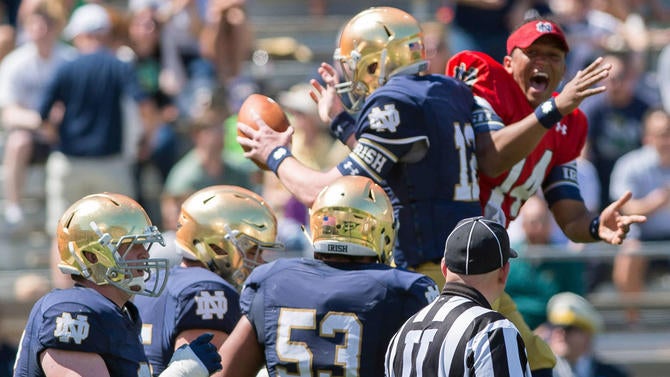Considering it's May and there typically isn't a whole lot going on in the college football world at this time of year, it's no surprise that satellite camps and conference realignment have dominated the headlines. The later specifically in the Big 12, where we could see the smallest of the Power Five conferences soon expanding back to 12 schools.
I'm not exactly convinced that expanding will solve any problems for the Big 12, which is why last week I decided to rank the Big 12 schools I thought would be most desirable to the other Power Five conferences should those leagues decide to raid the southwest.
This week we continue the realignment theme, but instead of thinking of possible fits for the Big 12, I'm going to list five conference realignment moves I'd like to see made (no order). The odds of any of these moves happening are about equal to those of a MAC school winning the 2017 College Football Playoff, but like I said up top, it's May.
At the end, all five of the moves are somewhat related. In a way, they're more like conference trades than they are expansion or realignment, and I believe that -- athletics-wise, anyway -- they're all moves that make quite a bit of sense.
1. The SEC trades Kentucky to the ACC for Miami. Just a straight up swap of schools. While ACC football fans may not be excited about the prospect of losing Miami to the SEC, the truth is that Miami hasn't actually done anything of true significance on the football field since it joined the ACC. Still, at its heart, Miami is a football school, and that's attractive to the SEC. Putting Miami in the SEC East alongside Florida, Georgia and Tennessee certainly strengthens the division.
While Kentucky won't do anything to improve the ACC's overall football strength, it will still hold on to Clemson, Florida State, Louisville and Virginia Tech. Also, adding Kentucky could help the ACC realign its football divisions so they're a bit more balanced football-wise. I'm not sure having Florida State, Clemson and Louisville sharing the same division is what's best for the conference in the long term.
What really convinces the ACC to make this deal is what Kentucky brings from a basketball standpoint. Listen, the ACC considers itself a strong football conference, but we all know damn well that basketball is the its true passion. Adding Kentucky's basketball program to a conference that contains Louisville, North Carolina, Duke, Syracuse and Virginia? There's no question that the ACC would be the best college basketball conference in the country, which would be more than enough for many ACC fans.
2. Nebraska and Colorado return to the Big 12.You know who the perfect expansion candidates are for the Big 12 right now? Two of the schools it lost. Sure, you can easily argue that Missouri or Texas A&M are better, but both of those schools seem happy with their new homes, and Nebraska and Colorado feeling homesick at least feels more realistic.
Sure, Nebraska enjoys cashing the checks the Big Ten provides, but I don't know that the Big Ten is what's best for its football program. Returning to the Big 12 would not only reunite Nebraska with its old rivals, it would also reunite it with its recruiting familiarity in the state of Texas. While Nebraska doesn't exactly stick out like a sore thumb in the Big Ten, I just can't help but believe it'll always be a better fit in the Big 12 (Big 8).
I could say the same about Colorado. Games against USC and Arizona State just don't have the same cache as Colorado games against Oklahoma or Nebraska did. Still, the biggest reason I'm moving Colorado back to the Big 12 isn't just because it benefits the Buffaloes or the Big 12, but also because in another one of my moves, the Pac-12 has to make some room.
3. The Pac-12 trades Oregon State to the Mountain West for Boise State, signs BYU as a free agent.Let's be honest. While Oregon State is one of original members of what's now the Pac-12 -- it was one of the original four members of the Pacific Coast Conference -- at this point, it doesn't bring a whole lot to the table athletically. It's football program had some success under Mike Riley, but historically, it's very hard to win there. The basketball program doesn't exactly set the world on fire. By sending Oregon State to the Mountain West, as far as athletics are concerned, the Pac-12 might actually be doing it a favor.
Sure, there's no way the Mountain West would want to give up Boise State for Oregon State, but the Pac-12 is still a Power Five conference. In this imaginary world, that means it can do whatever the hell it wants. So the Pac-12 replaces Oregon State with a solid football program to add to its North Division to compete with Stanford, Oregon and Washington. Then, to replace Colorado -- which has left for the Big 12 -- the Pac-12 hits the free agent market and signs BYU. The Cougars finally find their Power Five home (and the Pac-12 seems more BYU than the Big 12), and they're slotted in the South. Right next to Utah.
So not only does the Pac-12 improve its football strength, but it adds one of the biggest rivalries in college sports to its conference as well. The entire South Division is now made of the USC-UCLA rivalry, the Arizona-Arizona State rivalry and The Holy War. The North has Stanford-Cal, Washington-Wazzu, and now Oregon-Boise. Sure, it's not The Civil War, but it'll probably be for higher stakes more often.
4. The Big Ten trades Maryland to the ACC for Pitt. The only reason the Big Ten added Maryland in the first place was for all the cable boxes. The only reason Maryland left the ACC to join the Big Ten was because the school was broke, and the Big Ten offered the promise of big-time checks in the future. Both of these things are still true, but I'm sorry, Maryland is never going to feel like a Big Ten school. Rutgers has been enough of a nomad in the past to make it blend in eventually, but will anybody ever truly consider Maryland a Big Ten school? Maryland is an ACC school. Maryland should be an ACC school.
So the Big Ten sends Maryland back home to the ACC where it joins Kentucky in continuing to form a basketball superconference, and the Big Ten gets back a program that always seemed like a more natural fit for it in Pitt.
Maryland also provided Penn State a "natural rival" in the Big Ten, which it never had. Well, Pitt is a much better rival for Penn State than Maryland could ever hope to be. Also, when you think of Pittsburgh itself, you think of a blue-collar, Rust Belt city, which certainly fits in with the rest of the Big Ten -- particularly in the East.
5. Notre Dame finally just joins the Big Ten. The Big Ten lost Nebraska earlier, so it's currently sitting at 13 schools. But don't worry, its newest school is the one that should have been a Big Ten school all along. You want to balance the power between the divisions in the Big Ten?
Put Notre Dame in the West to replace Nebraska. Sure, Nebraska is considered a traditional power, but it hasn't been as successful as Notre Dame has been this decade. Notre Dame provides the West with a team that could actually stand up to Michigan and Ohio State, as well as Michigan State and Penn State.
Plus, wouldn't you rather see Notre Dame playing against Big Ten opponents like Michigan and Michigan State during the season instead of NC State and Wake Forest? I know I would.






















